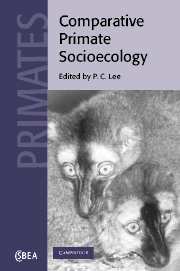Part 2 - Comparative life history and biology
Published online by Cambridge University Press: 24 August 2009
Summary
Editor's introduction
In 1959, Le Gros Clark characterised the Order Primates by their generalised limb structure, the retention of give digits, and a number of derived morphological and physiological traits. In particular, these traits were the elaboration of the visual system and reduction of olfaction, the expansion of the brain, especially the cerebral cortex, invasive placentation, reduced litter size and the prolongation of postnatal life. Whereas a number of these traits is also shared with other living non-primate taxa, the suite of traits associated with reproductive rates and cognitive capacities among primates continues to intrigue.
Possibly the greatest expansion in research interest over the 20 years since Clutton-Brock and Harvey attempted their comparative study of primate socioecology in 1977 has been in the areas of life histories and reproduction. This section presents some recent work. But, there is a more fundamental question of interest: do these specialisations in brains, life histories and reproductive biology arise from ecological adaptations? Do they enable ecological adaptations? And do they constrain primate social systems? By exploring such questions, life history studies can provide a background to the comparative socioecological work that follows in Part 3. Thus, in order to understand the function of social systems and their evolutionary patterns, we also need a perspective on the conditions (physiological and morphological) and constraints on the organisms.
As Blurton Jones et al. (Chapter 6) note, primate life histories were first compared by Adolph Schultz in 1934. Even with the scant data then available on gestation length, duration of lactation, age at first reproduction and life span, his proposed pattern illustrated the primate phenomenon of a ‘time strategy’ rather than an ‘energy strategy’.
- Type
- Chapter
- Information
- Comparative Primate Socioecology , pp. 71 - 72Publisher: Cambridge University PressPrint publication year: 1999



